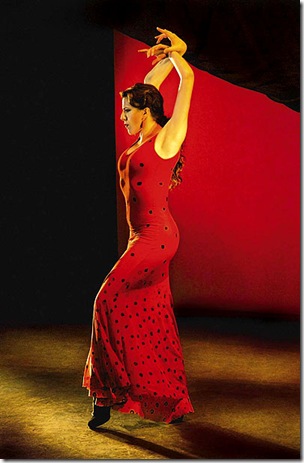María Pagés : a force of nature, a delicately wild “bruja” who inspired Nobel Prize winner José Saramago
Photo courtesy of the National Arts Centre.
Flamenco acquired an entirely new meaning with this Self-portrait choreographed by María Pagés. The evening was made up of various moments inspired by the development of her personal and artistic life, each moment emerged from one of several Flamenco rhythms that defined the form, the style and the atmosphere of her choreography so she was never at all removed from the Flamenco origins of her work which showed all the traces of its Sephardic, Arabic and Moroccan origins . What was exceedingly beautiful to watch was Mme Pagés herself unfolding like some gracefully wild creature reconnecting with the earth.
Her whole body flows to one sweeping movement as her arms curl up in the air, and then wrap themselves around her body as it appears to sink into the ground or expand into the air and then swoop back to the stage as she takes her cuadra in hand and lovingly imposes her domination on the group. Her solos took her somewhere between the natural elements of the earth, and an enchanting witch who dissolves into the shadows, bringing a highly sophisticated rereading of a dance form that is both graceful, wild, magic and animalistic, almost as if a new species had come to life.
The dancing also revealed a refined reworking of Flamenco techniques as well as a return to its gypsy origins with stamping, yelling, the strong wailing voices of the singers, the guitars accompanied by the violins, the flirting, the hip swinging and all the movements that one expects from Flamenco, However there was also the chorus of young men and women, working as an impeccable dancing machine providing precise footwork, perfect synchronization, extended lines of dancers that moved out, that tightened their ranks. That had dancers turning their backs on their partners, then snapping back into ranks and flowing around the stage as a perfectly oiled ensemble. Amid all this corporeal control that never lost its grip for one second, the young men still seemed to exude a sense of great fun, virile self-pride, and a sense of tension that suggests the heightened theatricality of the performance , blurring the lines between the esthetic of dance and theatre. Enormous thought was given to the beautiful costumes. the earthy colours blended into the flowing forms of the gowns that enhanced the presence of Maria Pagés on a stage where Pau Fullana’s lighting design recreated the bodies and became the essential spatial element of transformation in that whole performance.
Something in the group choreography had the feeling of Balanchine’s geometric formalism which might have passed through Baryshnikov’s eyes and been assimilated by Pagés in that period of exchange when he met her in Madrid and then invited her to perform at the Baryshnikov Arts Centre in New York. Performers who bathe in the milieu of dance and theatre normally and instinctively interiorize such influences .
Mme Pagés was encouraged by the Russian dancer to create this Self-portrait through dance and it is not surprising that some of the the Russian formalism might have been passed into the group’s work on the chorus, creating something of absolute purity, of pure geometric form tinged with the earthy passion that goes beyond the formalistic moments of the dance displayed by the chorus.
The most moving moment, hearing the voice of Nobel Prize winner José Saramago, reading his poem in Portuguese, My Refuge- I Raise a Rose, an introduction to one of the segments relating to her relationship with poetry. If María Pagés ever returns to Ottawa , you must not miss her work.
